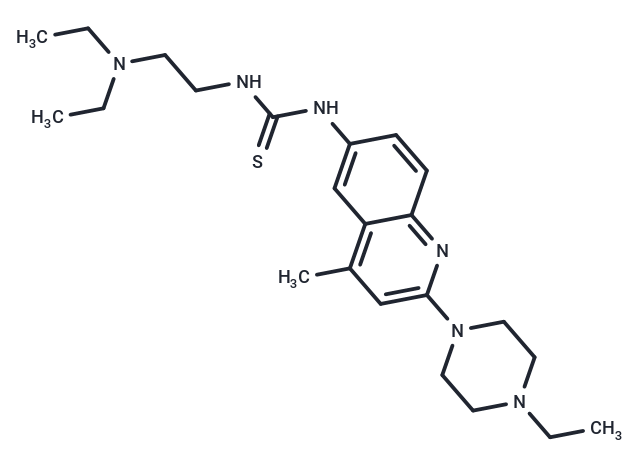Shopping Cart
- Remove All
 Your shopping cart is currently empty
Your shopping cart is currently empty
D-I03 is a selective RAD52 inhibitor with a Kd of 25.8 µM. It specifically inhibits RAD52-dependent single-chain annealing (SSA) and D-loop formation, with IC50 values of 5 µM and 8 µM, respectively. D-I03 also inhibits the growth of BRCA1 and BRCA2 deficient cells and prevents the formation of damage-induced RAD52 foci, but does not affect RAD51 foci induced by Cisplatin.

| Pack Size | Price | Availability | Quantity |
|---|---|---|---|
| 1 mg | $31 | In Stock | |
| 5 mg | $70 | In Stock | |
| 10 mg | $128 | In Stock | |
| 25 mg | $263 | In Stock | |
| 50 mg | $392 | In Stock | |
| 100 mg | $575 | In Stock | |
| 200 mg | $818 | In Stock | |
| 1 mL x 10 mM (in DMSO) | $77 | In Stock |
| Description | D-I03 is a selective RAD52 inhibitor with a Kd of 25.8 µM. It specifically inhibits RAD52-dependent single-chain annealing (SSA) and D-loop formation, with IC50 values of 5 µM and 8 µM, respectively. D-I03 also inhibits the growth of BRCA1 and BRCA2 deficient cells and prevents the formation of damage-induced RAD52 foci, but does not affect RAD51 foci induced by Cisplatin. |
| Targets&IC50 | D-loop:8 µM, single-chain annealing (SSA):5 µM, RAD52:25.8 µM (Ki) |
| In vitro | D-IO3 (0-10 μM; on Days 1 and 3; Capan-1 and UWB1.289 cells) treatment preferentially inhibited the growth of Capan-1 and UWB1.289 cells in a concentration-dependent manner . D-IO3 inhibited cisplatin-induced RAD52 foci formation in the BCR-ABL1-positive BRCA1-deficient 32Dcl3 mouse hematopoietic cell line expressing GFP-RAD52. In the presence of D-IO3 (2.5 μM), the proportion of cells with RAD52 lesions decreased from 38.7% to 171%; meanwhile, the proportion of cisplatin-treated cells without lesions increased from 48.4% to 71.9%. D-IO3 had no effect on cisplatin-induced RAD51 foci. Similarly, D-I03 alone (in BRCA1-deficient cells) induced neither RAD51 nor RAD52 lesions, indicating that D-I03 has low genotoxicity[1]. |
| In vivo | D-IO3 (50 mg / kg / day; intraperitoneal injection; daily; 7 consecutive days; nu / nu mice) treatment can reduce the growth of BRCA1-deficient MDA-MB-436 tumors. Talazoparib puls D-I03 does not cause any obvious toxicity to normal tissues and organs, and does not affect the growth of BRCA1-positive tumors. Pharmacokinetic and toxicity studies have shown that the maximum tolerated dose of D-I03 is ≥50mg / kg and t1 / 2 is 23.4 hours, resulting in a maximum concentration in peripheral blood> 1μM[1]. |
| Synonyms | DI03 |
| Molecular Weight | 428.64 |
| Formula | C23H36N6S |
| Cas No. | 688342-78-1 |
| Smiles | CCN(CC)CCNC(=S)Nc1ccc2nc(cc(C)c2c1)N1CCN(CC)CC1 |
| Relative Density. | 1.147 g/cm3 (Predicted) |
| Color | Yellow |
| Appearance | Solid |
| Storage | Powder: -20°C for 3 years | In solvent: -80°C for 1 year | Shipping with blue ice/Shipping at ambient temperature. | |||||||||||||||||||||||||||||||||||
| Solubility Information | DMSO: 90 mg/mL (209.97 mM), Sonication is recommended. | |||||||||||||||||||||||||||||||||||
| In Vivo Formulation | 10% DMSO+40% PEG300+5% Tween 80+45% Saline: 3.3 mg/mL (7.7 mM), Sonication is recommended. Please add the solvents sequentially, clarifying the solution as much as possible before adding the next one. Dissolve by heating and/or sonication if necessary. Working solution is recommended to be prepared and used immediately. The formulation provided above is for reference purposes only. In vivo formulations may vary and should be modified based on specific experimental conditions. | |||||||||||||||||||||||||||||||||||
Solution Preparation Table | ||||||||||||||||||||||||||||||||||||
DMSO
| ||||||||||||||||||||||||||||||||||||

Copyright © 2015-2025 TargetMol Chemicals Inc. All Rights Reserved.